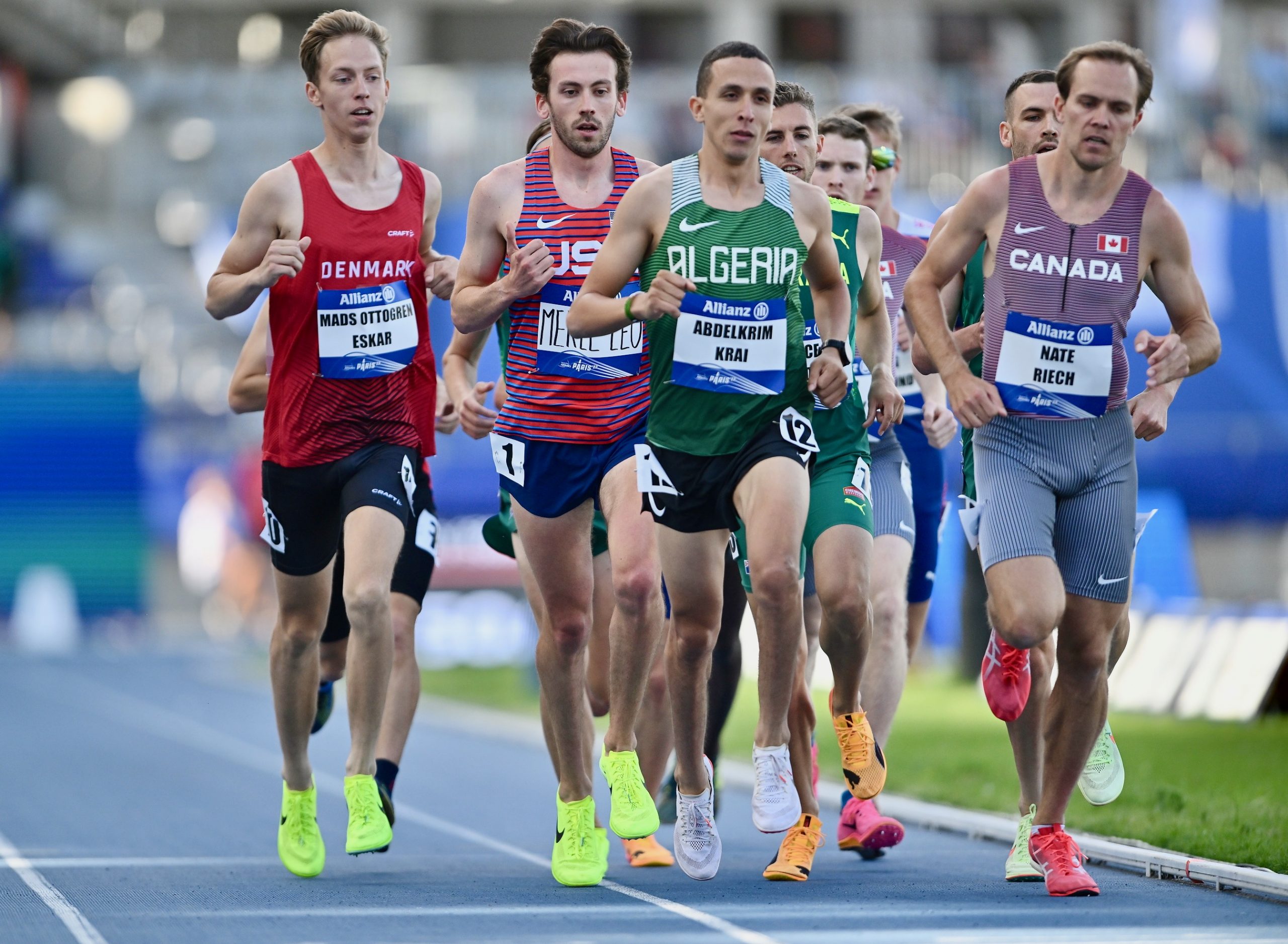Student Profile: Leo Merle nears the finish line for dental school with another goal – improving on his world-class success as a para athlete in the 1,500-meter run20 min read
This profile is one in an ongoing series highlighting School of Dentistry alumni, donors and students.
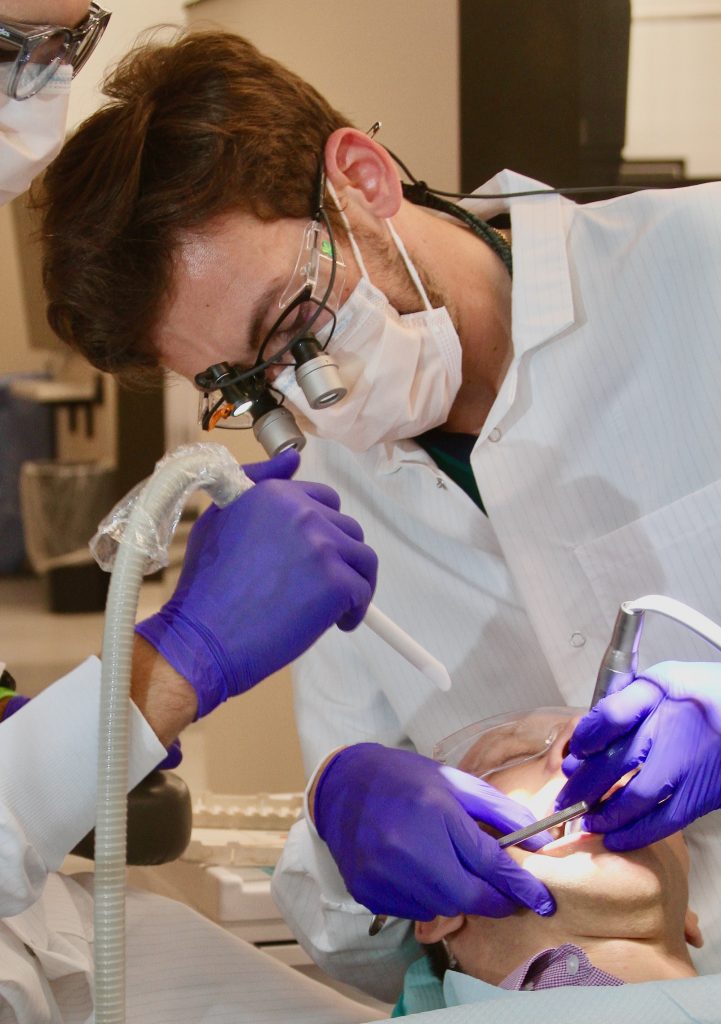
Leo Merle has a couple of significant quests underway at the moment.
Foremost is finishing his final year at the University of Michigan School of Dentistry on his way to his Doctor of Dental Surgery degree after graduation next May. That outcome is virtually assured as he steadily makes his way through the various types of patient treatments that are left on the list of requirements he must complete to graduate. The goal of becoming a dentist is challenging, but at least he knows ahead of time exactly what he must do to cross the finish line.
Merle’s second quest also involves a finish line, but how fast he will cross it is much more uncertain. Merle is a world-class runner who recently competed in the Para World Championships in Paris, France. Merle is the U.S. record-holder for para athletes in the 1,500-meter run. In Paris, he lowered his American record slightly and finished fourth in the world. While being fourth in the world is impressive, Merle has his sights on another goal that will require continuing to qualify for nationally- and internationally-sanctioned championships around the world, possibly including the Paralympics that follow the Olympic Games in Paris in 2024.
His goal: Be the first American with cerebral palsy to run the 1,500 meters in less than 4 minutes. He will need to trim slightly more than 6 seconds off his personal best of 4:06.13. While that might seem like an easy gap to close, cutting six seconds is a significant challenge for world-class distance runners who have trained for years and have already lowered their personal bests to highly competitive levels.
Competing in Paris was an incredible experience, Merle says, but running is secondary to dentistry. As the summer winds down, he is back to his main focus of treating patients in the dental school clinics and making sure he is on track to graduate. Here’s the story of how he became interested in dentistry, the phone call that brought him to the University of Michigan and more about his fairly recent journey into para athletics on the national and world levels.
Dentistry comes first
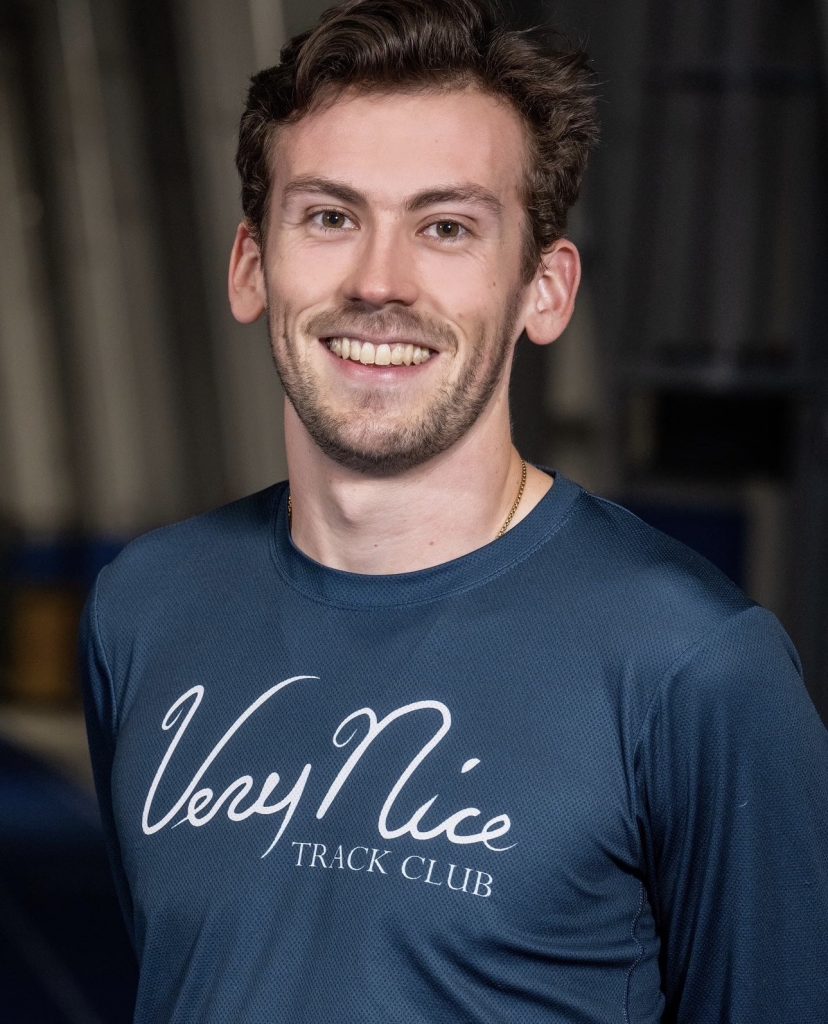
Growing up in Folsom, California, Merle was interested in both art and science. He played the piano and woodwind instruments, including the bassoon, and was interested in concert performance, perhaps as a college major. On the science side, his mother manages a plastic surgery center so he learned a lot about health sciences and medicine from her work; a doctor at the center encouraged him to consider a career in plastic surgery. In high school, he discovered biology and remembers his reaction: “Cells are the coolest thing in the world, this is amazing.”
Merle decided against majoring in music in college, instead choosing science with the idea he would figure out a career as he went along. He majored in molecular, cellular and developmental biology at the University of California – Santa Cruz, a course of study that included research in biomechanical engineering all four years.
As he mused about his dual interest in art and science, he began to think about dentistry. It wasn’t something he was fond of, given the considerable amount of time he had spent in a dental chair as a child because of his poor brushing and flossing habits back then. Yet as he shadowed a dentist in his hometown one summer during college, dentistry seemed like an excellent career option. “I just absolutely loved it – learning all the procedures,” he said. “I thought it was really cool, really interesting. It confirmed the idea that it is a combination of art and science. You still get to be someone’s doctor in one sense and you are also an artisan in another sense. Having those two worlds together, I loved that.”

Merle began working on dental school applications while he was in a study-abroad program at Utrecht University in the Netherlands during his junior year of college. He applied to schools across the U.S., hoping to expand his horizons outside of California. After a series of interviews at several schools, he narrowed his final preferences to two – one on the East Coast and the University of Michigan. They were so equal in his estimation that he couldn’t decide which he would choose if they both offered him admission. He came up with an unusual tie-breaker method. “I made a pact with myself and said: Whichever school reaches out first is the one that wants me more. Both admission offices said they would reach out on Dec. 2. I waited and Dec. 2 came and I saw an unknown number from Ann Arbor on my phone’s caller ID. It was the U-M dental school so I decided U-M is the place for me.”
Now more than three years into his time in Ann Arbor, he’s pleased with his decision and his progress. The first two years of mostly classroom work and simulated treatment using wax teeth models and mannequins are difficult as students prove to faculty – and to themselves – that they can meet the requirements, he said. Then the third year with patient appointments is a transition to gaining confidence. The fourth year, where he finds himself now, is about refining his skills, applying evidence-based research to treatment decisions and establishing a rapport with patients.
Outside of class and clinic, Merle was president of his class the first year and is serving as vice president this year. Among his more rewarding dental school experiences was a trip to Kenya as part of the school’s Global Initiatives in Oral and Craniofacial Health program. Kenya is one of several countries where small groups of dental students and faculty deliver preventive and minimally invasive caries interventions to school children, train local teachers to sustain the program throughout the year, and visit local dental and medical facilities and schools to interact with local healthcare practitioners. Such trips meet oral health needs in low-income areas and provide important learning and cultural competency opportunities for the dental students.

Merle and his fellow students applied silver diamine fluoride and other cavity-prevention treatments to the Kenyan children’s teeth. There were no dental chairs in the makeshift outdoor clinics, so some of the children reclined on wooden benches from their school. Despite dirt floors in some of the classrooms, unstable power and water systems, and hand-me-down school uniforms, the children’s constant smiles and curiosity were infectious.
“My biggest takeaway from that Kenya trip was that there isn’t much that is needed to satisfy a person if you are truly happy,” Merle said. “In the two weeks we were there, I did not see a frown from the children while we were setting up, playing with them, or when they were introducing us to something. They showed me true humanity in their kindness and curiosity. The love and affection these kids radiated was palpable and really special to feel so far from home.”
As he works his way through his final year, Merle is tentatively looking ahead to more dentistry education in endodontics, though maybe not immediately after receiving his DDS. Patients who need endodontists are often suffering varying levels of pain, so the ability to stop the pain is a powerful reward for a dentist. He also says the precision involved in root canals and other aspects of endodontics appeals to his perfectionist tendencies. For example, he cites a case where half a millimeter made all the difference: 21 millimeters was too far, 20 millimeters was too short and 20.5 millimeters was exactly how the procedure worked best. “That precise nature of it, being almost perfect, that striving for being perfect at something, I really love that,” he said.
Running at his pace
If millimeters are a measure of success in dentistry, the equivalent in competitive running is a time measured in hundredths of a second. When Merle first began running in junior high and later in high school, finish times didn’t mean much. He was not one of those childhood phenoms who took up the sport as a kid, devoted most of his time to it and began winning races immediately. Early on, running for him was not even close to competitive. It was a way to be with his friends and to exercise.
Exercise was important. Merle was born with a form of cerebral palsy that affects flexibility in his right foot and leg. From the time he was a baby until he was six years old, he wore a corrective boot designed to stretch the tendons of his right leg so they would develop properly and maintain their flexibility. During his childhood, his parents didn’t tell him he had a disability; instead, they encouraged him to play sports year-round, and he did – baseball, basketball, soccer.
Merle’s entry into the sport of running was with the 7th grade track team. He was slow but he stuck with it because, most importantly, it allowed him to hang out with many of his friends. In high school, he became more serious about training. He ran the 1,600 meters (just short of one mile) and was on the cross country team with longer distances. By then, he had grown to love running and wasn’t deterred by the fact that he was not winning races and not among the top runners at his high school. When he enrolled in college at UC-Santa Cruz, he joined the track team as a way to offset the stress of a heavy academic load. He competed in 8-kilometer cross country races (about 5 miles) and the 1,500 meters, among others. As in high school, he enjoyed running and his times were improving, which was rewarding, so he wasn’t discouraged by being outpaced by other teammates with faster times.
In 2019, after his junior year of college, Merle made a discovery about para athletics that opened an incredible new chapter in his life. He learned that the international para athletic movement has a wide range of categories for athletes with physical limitations, including those with cerebral palsy. Para athletics has grown in widespread recognition in recent years thanks in large part to television coverage of the Paralympics that now immediately follow the Olympic Games every four years. The most prominent para athletes are those who compete in wheelchairs or amputees who run with prosthetic “blades” for sprints and longer races. However, para athletics offers many categories for athletes with a wide range of disabilities, including those with cerebral palsy, spinal injuries, visual impairments and intellectual disabilities.
Merle wanted to attend a para athletics competition in-person and determine whether he would qualify for the sport, so in 2019 he traveled to Minneapolis, Minnesota, for the U.S. Junior National Championships for athletes under the age of 23. Officials tested him with regard to his disability and confirmed he was eligible to run the 1,500 meters in a classification called T-38, for people with similar cerebral palsy impairment. Merle, who describes his form of the condition as mild, said officials assess each competitor to determine the tightness of their muscles and tendons and how much flexure the muscles have.
Once his para eligibility was approved, officials had even better news when they learned of Merle’s best time in the 1,500 meters. They told him that if he replicated that time at a sanctioned event, he would likely qualify for the overall U.S. national para athletic team that competes around the world.
Merle had traveled to Minneapolis to merely observe the meet and learn if he qualified for para athletics. Given his new para certification and news about his competitive 1,500 time, he decided to lace up his running shoes and enter the event that weekend. The result: In his first competition as a para athlete, he set the U.S. record in the 1,500 meters.
He had been running with able-bodied athletes for years and usually trailed the top runners. Suddenly, he had set a U.S. record in a competition that included para athletes from around the country. He has since run in successive national competitions in Minnesota, Florida and California, each time lowering his U.S. record. His last event, in San Diego last May, qualified him for the U.S. national team and the trip to Paris in July for the Para World Championships.
The 1,500-meter race in Paris was on July 17, the last day of a 12-day stay organized and paid for by the World Para Athletics organization, which is a subcommittee of the International Paralympic Committee. Merle stayed in a Paris hotel with the rest of the U.S. team, which includes many long-time and well-known para athletes. His room was across the hall from 20-time medalist Tatyana McFadden, one of the greatest U.S. Paralympians of all time who competes in wheelchair events from sprints to marathons, and skiing in the winter games.
Merle spent the first 11 days of his stay getting acclimated to the time change, adjusting to the weather and doing training runs alone and with teammates on the streets of Paris. It was surreal as he ran down the narrow streets and through the plazas of some of the city’s famous arrondissements. At one point, he looked up and realized he was in front of the Louvre. He ran to the Eiffel Tower and past Notre Dame. Running past iconic landmarks in Paris is far – literally and figuratively – from his usual Ann Arbor training runs through Argo Park, the Arb and the dirt roads around Barton Hills.
“That’s the beauty of distant running – you get to run anywhere,” Merle said. “That’s what I love so much about running. It immediately embeds you in the greater community and culture of the surrounding area because you are just doing what anybody else in the community would do.”
The 1,500-meter world championship race was held at Charléty Stadium and was carried live by Peacock, the streaming service. Merle competed against runners from Canada, Australia, Algeria, France, Denmark, Norway, Belgium and Kenya. A Danish runner sprinted out to an early lead in the nearly four-lap race, but the other runners knew based on that runner’s previous times that he couldn’t keep up that pace. Eventually, a Canadian and three Australians formed a lead pack ahead of Merle and the rest of the field. Merle bided his time until the last lap, then closed on the leaders in the home stretch, passing one of the Australians shortly before the finish line. Although Merle finished fourth, one place out of the medal group, he finished ahead of three runners who had previously run the event faster than him. Canadian Nate Riech won the event in 4:03.07 ahead of two Australians and Merle with his American record at 4:06.13.

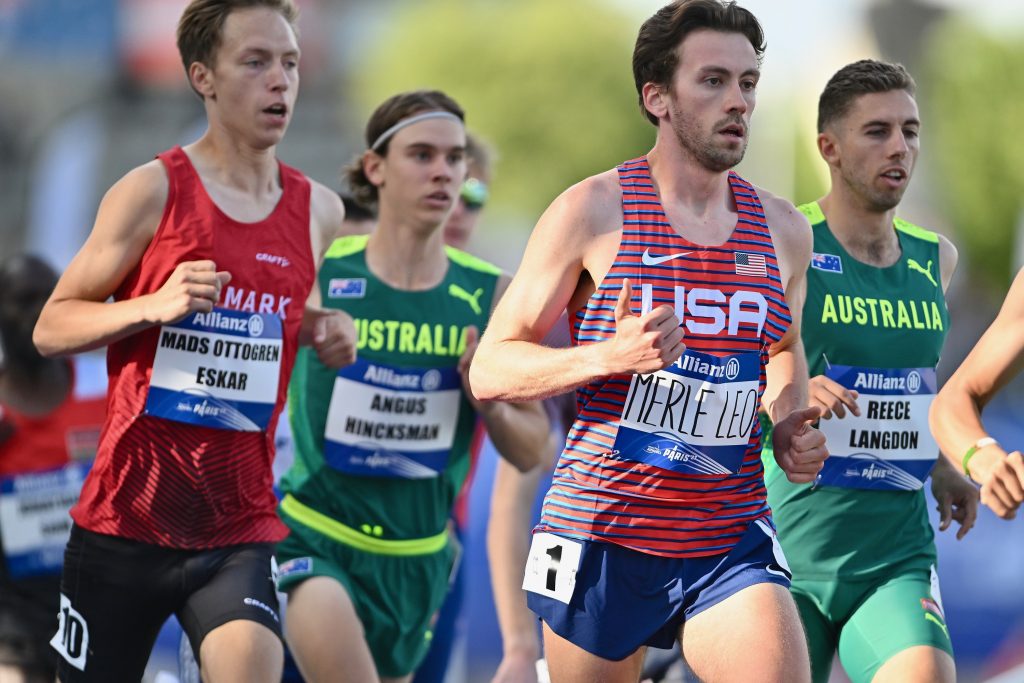
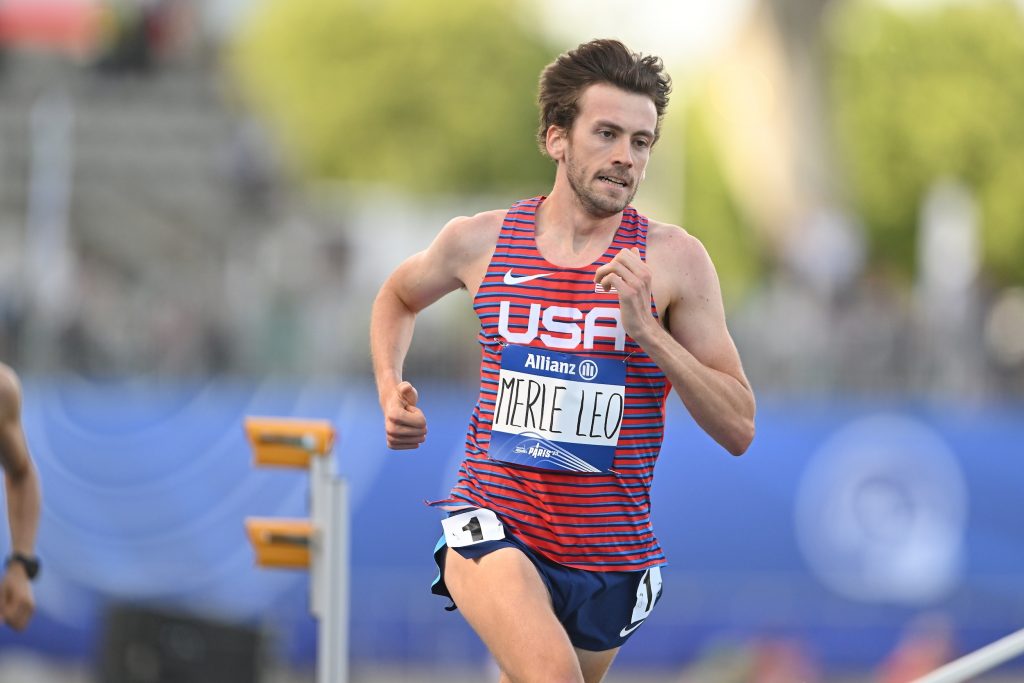
The dentistry-running mix
The day after his race in Paris, Merle flew back to Michigan and by the next morning at 8:30, he was again immersed in the dental school routine, treating a patient during a regularly scheduled appointment. As he finishes his requirements for graduation, he is considering his options for dentistry. Beyond his interest in a graduate degree in endodontics, he also enjoys teaching so joining academia as a faculty member is a possibility. He is thinking ahead but not yet ready to commit to the next step, which will come after commencement next May.
Beyond the technical dental skills he is refining, he also feels comfortable with the people skills required for dentists. The U-M dental school insists that its students understand the evidence-based research behind the many and varied treatment procedures patients receive. That involves building a rapport with patients so that they understand and trust their options and ultimate treatment. Merle takes the time to explain to patients the reasons and evidence behind the options, a conversation that usually ends in the patient expressing that they trust his guidance.
“I think that feeling of ‘this person trusts me in the decisions I am making for them’ is amazing. There’s something extremely rewarding and important about that feeling that they trust you 100 percent for what you are doing. They have asked questions and you have explained the options and the reasoning about what is best for their health. Building that sort of trust is incredible.”
Moving forward in coming months, there is a logical symbiosis for Merle in the relationship between dentistry and running. Dental school is challenging, with his final requirements looming in the last few months of his DDS education. Running is his stress relief “so I can take a break and turn my brain off from dentistry.”
Those breaks are runs of 8-10 miles a day, six days a week, or about 50-55 miles a week. He often runs alone though he is part of the Very Nice Track Club, a local group of experienced runners led by retired U-M track coach Ron Warhurst. Merle also lifts weights twice a week in between his runs on streets and roads around campus and Ann Arbor.
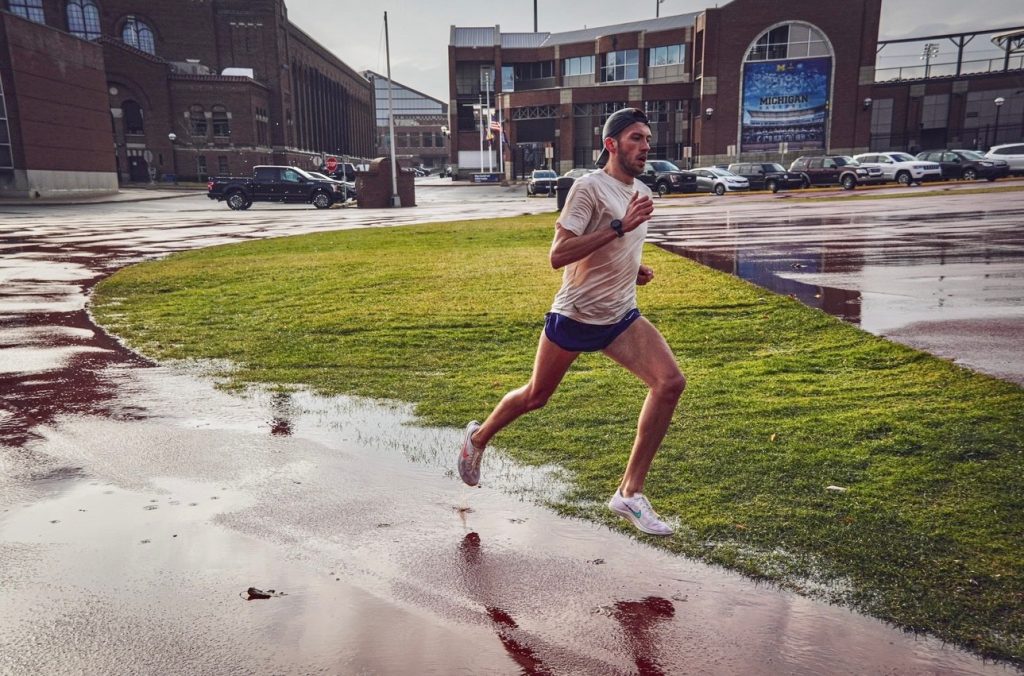
And if running is a healthy break from dentistry, dentistry keeps him from becoming obsessive about the running. Dating to when he first started running in junior high, he has always considered running fun and even a passion, but he has always refused to make it such a pressure-packed activity that it loses its appeal. Even with his newfound world-class running prowess, he makes it a point to frequently say that dentistry comes first and running is second.
When he was around other para athletes at national meets, he noticed that many have made training for their event almost their entire lifestyle. When they didn’t win nationally or qualify for world events, some seemed devastated. “I’m in the lucky situation where running isn’t my life. It isn’t the only thing I’m doing,” he says. “A lot of people at nationals, all they do is run or throw or jump, and they didn’t make the world championships. All they did is train for that. But running’s not my primary thing. Dentistry is.”
That being said, Merle knows the opportunity to continue to represent the United States on the para team on the world stage is a great opportunity that he can’t pass up. As he continues his quest to be the first American with cerebral palsy to run the 1,500 meters in less than 4 minutes, his training regimen may dovetail nicely with qualifying for the 2024 Paralympics in Paris late next summer. He needs to plot his strategy for which sanctioned para meets he will enter between now and then to ensure his 1,500 time remains among the best in the world. Options include the Para Pan American games this November in Santiago, Chile, followed by the Para World Championships in May 2024 in Kobe, Japan.
Finishing fourth in the world was an incredible experience, he says. It has given him insight into how athletes who reach a high mark develop the desire to stay at that level.
“The crazy thing is I love the sport absolutely and I know I want to continue to stay competitive for a couple of years at least. But I know that my priorities are going to change. I don’t know when that line is going to be. Is it when I am 30 or 40 or 45? For now, I know I have to keep giving time allocation to both running and dentistry and we’ll see where it goes.”
###
The University of Michigan School of Dentistry is one of the nation’s leading dental schools engaged in oral healthcare education, research, patient care and community service. General dental care clinics and specialty clinics providing advanced treatment enable the school to offer dental services and programs to patients throughout Michigan. Classroom and clinic instruction prepare future dentists, dental specialists and dental hygienists for practice in private offices, hospitals, academia and public agencies. Research seeks to discover and apply new knowledge that can help patients worldwide. For more information about the School of Dentistry, visit us on the Web at: www.dent.umich.edu. Contact: Lynn Monson, associate director of communications, at [email protected], or (734) 615-1971.


